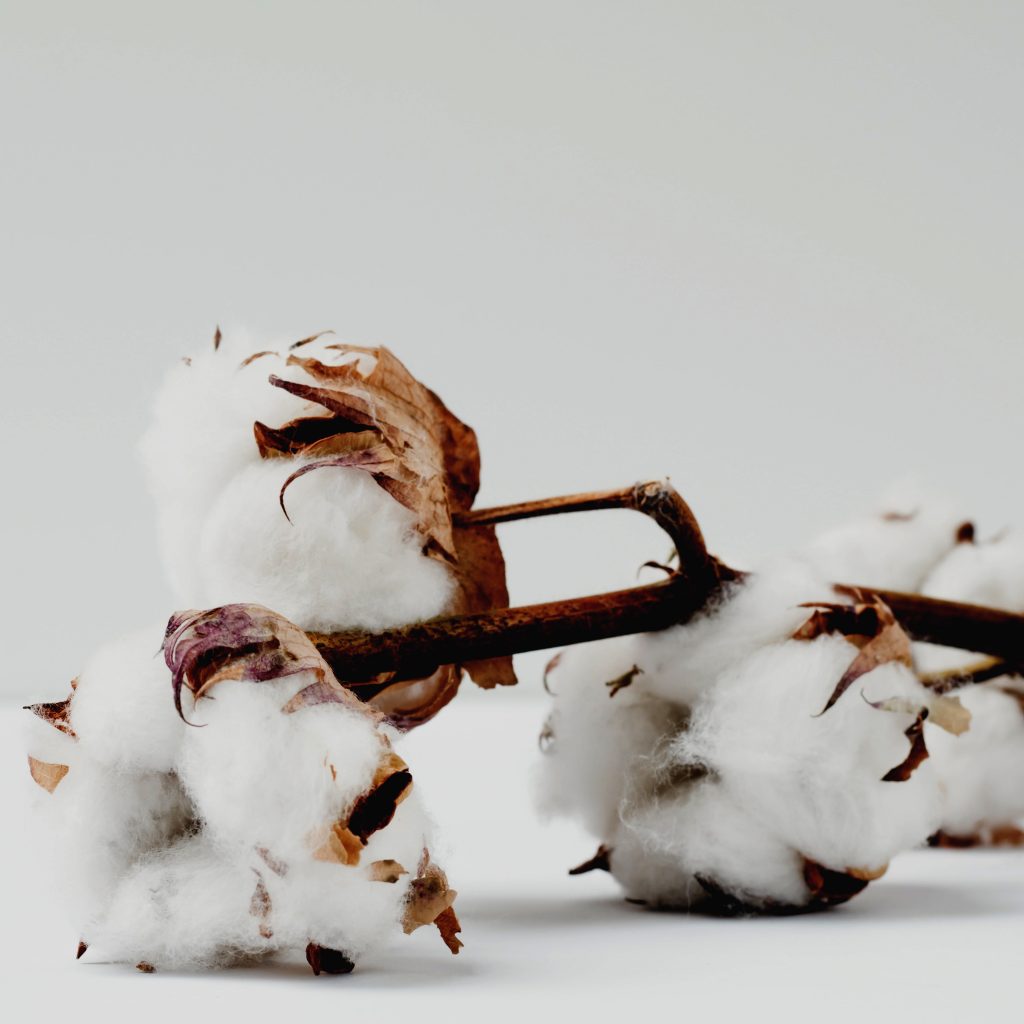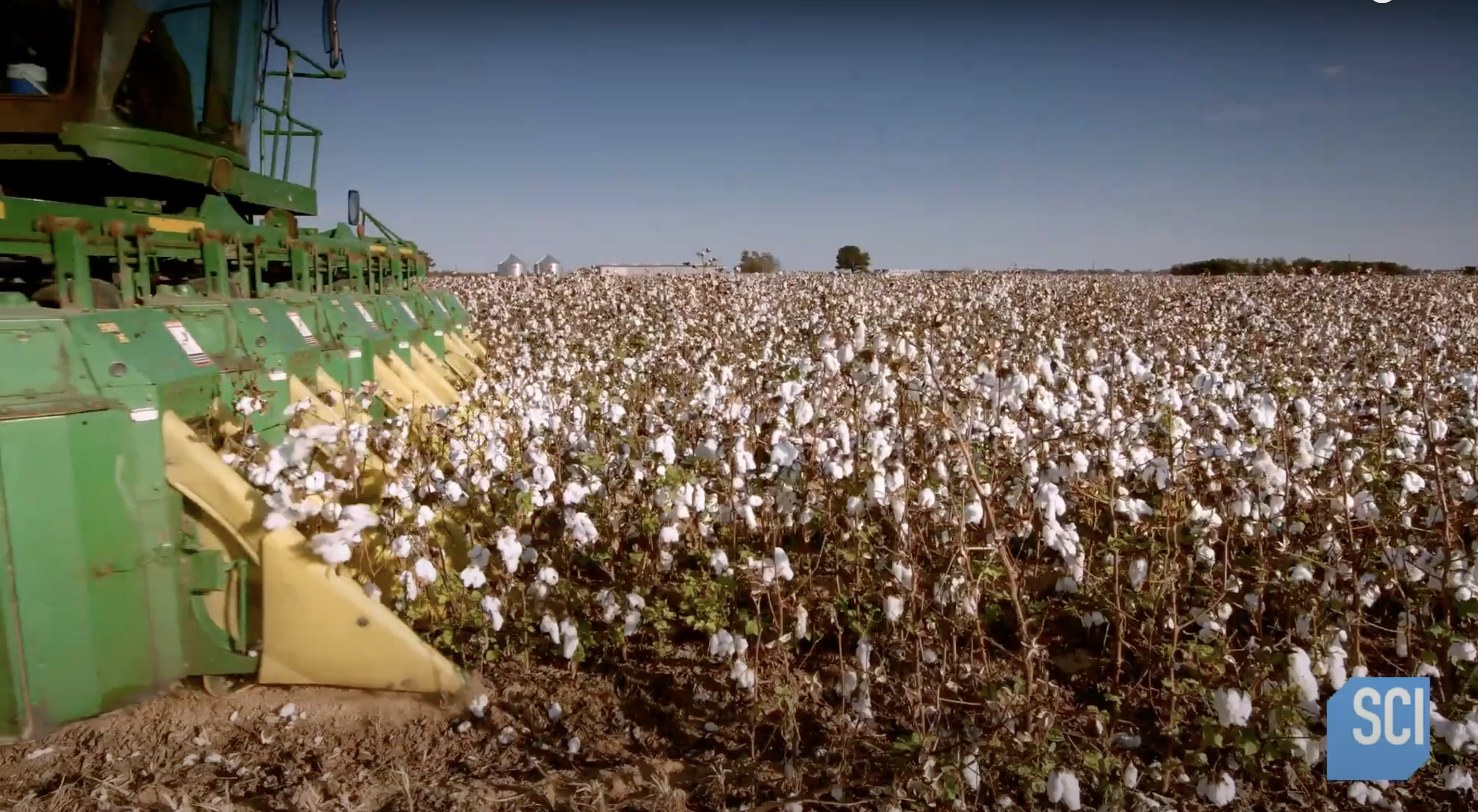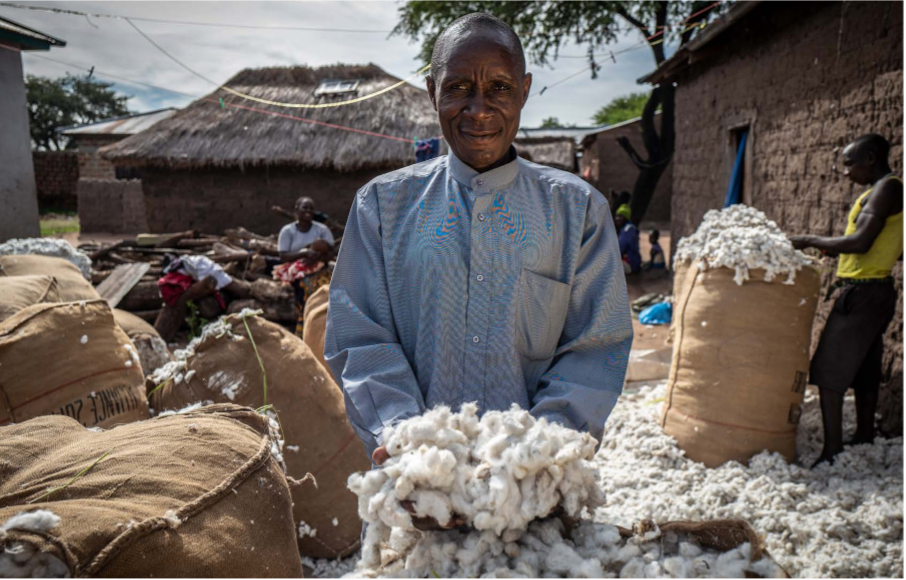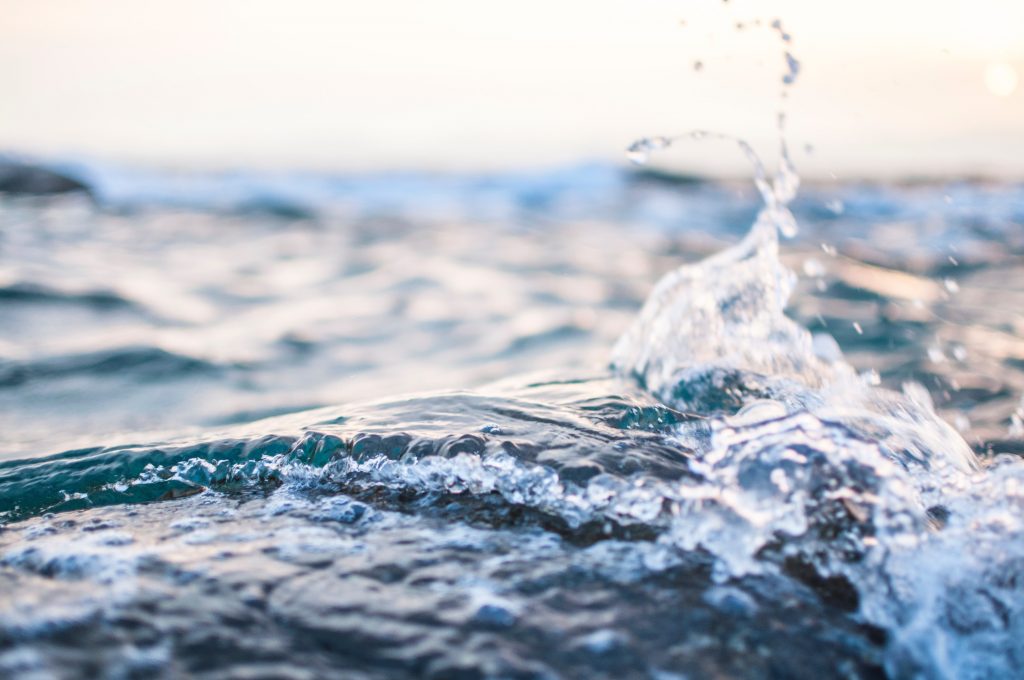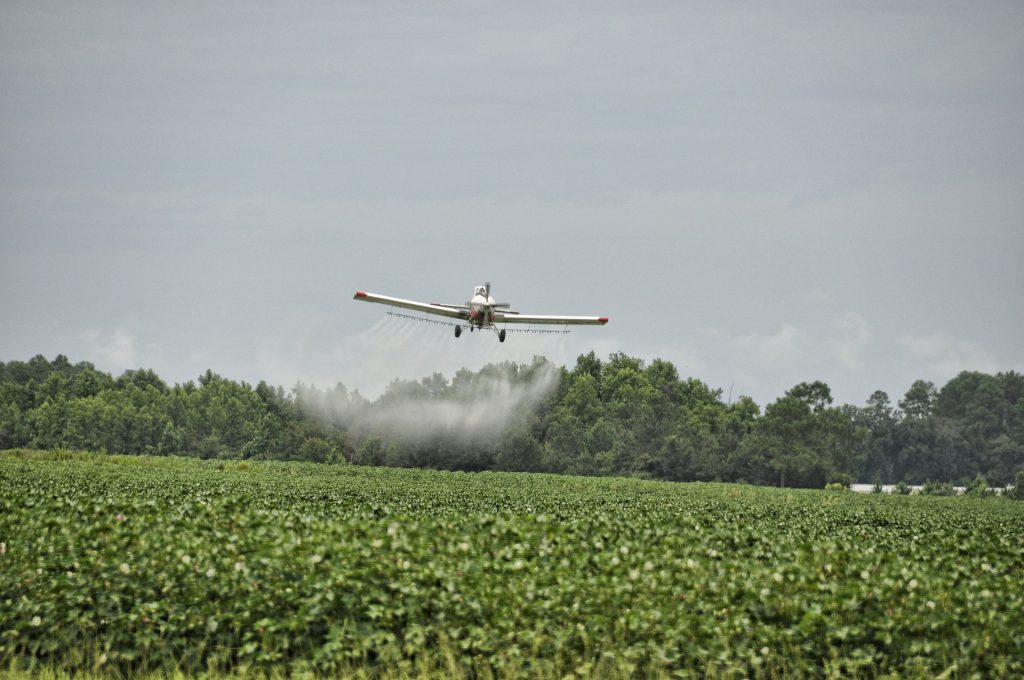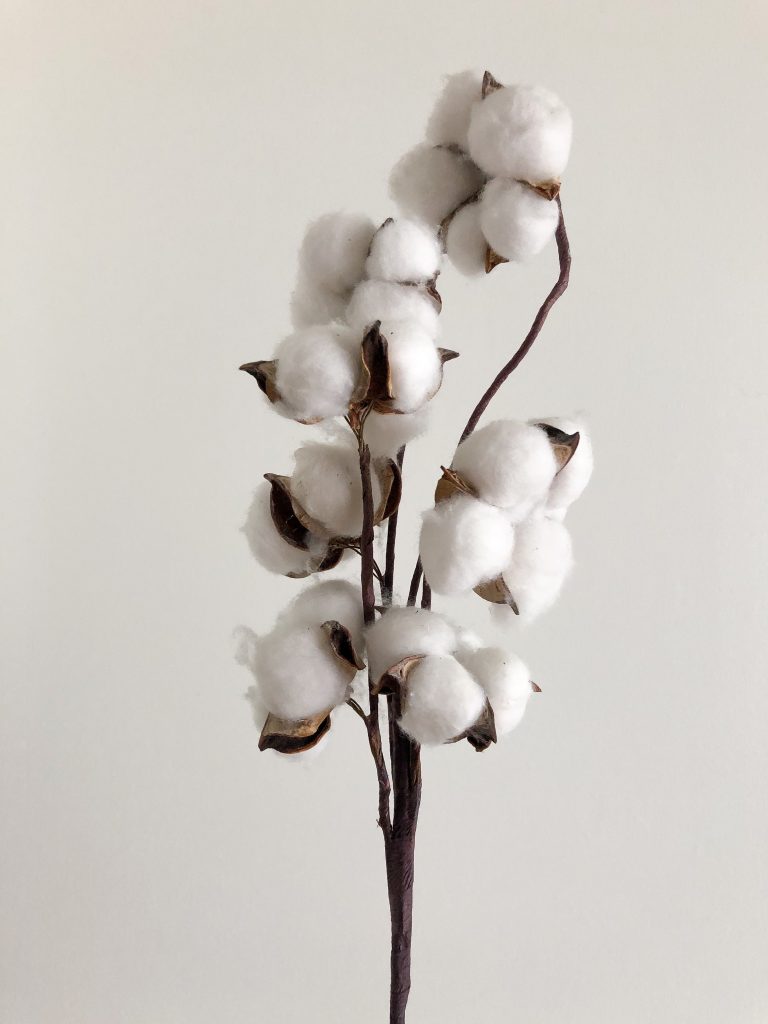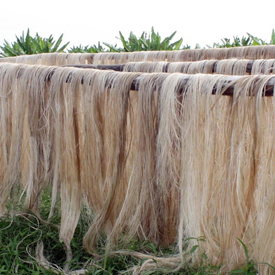Textile Info
Cotton Fibers & Sustainability
What are cotton fibers and how sustainable are they?
Cotton fiber is obtained from the cotton plant and consists mainly of cellulose. The length of cotton fibers varies from 22 to 50 mm with a diameter of 18 to 25 µm (Kozłowski, 2012). The longer the length of the fiber, the better the quality!
Cotton is known for being soft and comfortable on the skin. After finishing (explained below) cotton is hydrophilic, meaning it absorbs moisture easily. However, cotton also takes a long time to dry again. Cotton is a good conductor of heat, making cotton clothes cool (Kozłowski, 2012). It is easy to wash, but can shrink if washed too warm. Cotton is also prone to wrinkling, as you probably have experience with a cotton T-shirt that wrinkles quickly.
Cotton production steps
There are many steps involved in making yarn from cotton fiber. Every step has an impact on people and the environment and therefore on the sustainability of the fiber, yarn and final product that is made from it.
Cotton plantations can be found in countries with a subtropical climate such as China, India, Pakistan and the US. To grow cotton as quickly as possible in large quantities, a lot of water is needed and a lot of pesticides are used.
Water and pesticide use, are the biggest problems in cotton cultivation.
After the cotton is fully grown, it can be picked by hand or with special machines. After harvesting, the cotton still contains contamination such as cotton seeds and plant residues. Cotton is mechanically cleaned to remove as many plant residues as possible (ginning) before it is baled. The cotton bales are then transported to the spinning factory.
When all fibers are clean and well mixed, the spinning begins. Spinning consists of several steps. First the fibers are carded, to get all fibers neatly laid in 1 direction, using a carding machine and a web of fibers is created. The web is formed into into coarse strands, called slivers. Next, the sliver is twisted and slowly drawn (stretched) at the same time, creating the yarn. Special spinning machines are used for industrial spinning, which consume energy.
After the cotton yarn has been spun, it can be used for weaving and knitting. However, cotton is naturally a bit yellowish and has a waxy layer. Before it can be colored, it is scoured and bleached (first finishing steps). During scouring, the waxy layer is removed, so that the cotton becomes hydrophilic and absorbs water and therefore also dye. With bleaching, the natural yellowish color is removed and the yarn becomes evenly white. Dyeing of yarns can be done in different ways with different machines and different dyes.
The finishing steps scouring, bleaching and dyeing use (harmful) chemicals and require a lot of water. Chemicals end up in wastewater. Cardoso (2013) gives a number of examples of contaminants that can be found in wastewater after scouring, bleaching and dyeing, such as: pesticides, caustic soda, solvents, metals and salts. After the yarn has been dyed, it must be rinsed well, which of course requires more water. Energy is also needed to heat the water to the right temperature. After dyeing, the yarn is wet and must be dried, which also uses a lot of energy.
Cotton & Sustainability
It is difficult to express in numbers how sustainable cotton is. On Made-By’s Environmental Benchmark, conventional cotton falls under Class E, the worst class. Below is a brief explanation of why cotton scores so poorly and what exactly has the most impact on the environment.
Worldwide production of virgin cotton
Do you have any idea how much cotton is produced worldwide, every year? Looking at the textile industry and all different fiber types that are being produced, cotton is the 2nd most important fiber in terms of volume (Truscott et al., 2020). With around 26 million metric tones (mt), it had a market share of approximately 23 % of global fiber production in 2019. 26 million mt is 26.000.000.000 kg of cotton. According to the Preferred Fiber & Materials Market Report 2020, only 25 % of that 26 million mt is preferred cotton. Preferred cotton is more sustainable cotton such as Better Cotton Initiative (BCI), Fairtrade cotton, or Cleaner Cotton.
...Water consumption
Exactly how much water is needed for cotton cultivation differs per country (climate and location) and per production method. Fletcher (2008) estimates the global average at 8000 liters for 1 kilogram of cotton. That is of course an awful lot if you imagine that you can only make 1 pair of jeans from 1 kilogram fiber. Kooistra & Termorshuizen (2006) also mention that the large amounts of water use, often cause problems such as salinization and depletion in the irrigated areas.
Pesticides & insecticides
Most people think of cotton as a “natural” product. Cotton is a natural fiber, but it is is one of the most chemically intensive crops in the world. Research by Kooistra & Termorshuizen (2006) shows that cotton cultivation is responsible for about 11% of worldwide pesticide consumption, while it covers only 3% of the worlds cultivated land. More specifically, insecticides (specifically against pests) used in cotton cultivation, represent 25% of the global consumption.
...
Cotton & Sustainability Facts
Around 26 million metric tons of cotton fiber are produces in the word annually. This is 26.000.000.000 kg of cotton!
Cotton is a very water intensive crop, using around 8.000 liter of water for only 1 kilogram of fiber.
Cotton cultivation is responsible for about 11% of worldwide pesticide consumption, while it covers only 3% of the worlds cultivated land. More specifically, insecticides (specifically against pests) used in cotton cultivation, represent 25% of the global consumption.
Other sustainability issues not mentioned yet are impact on soil quality and biodiversity, but also working conditions, health & safety and child labor.
26000000000 kg
of fibers are produced
worldwide,
in only 1 year!
8000 L
of water are used
for cultivation of
only 1 kg fiber.
11 %
of the worldwide pesticides consumption is used for cotton cultivation.
Referenties en suggesties om verder te lezen
La Rosa, A., & Grammatikos, S. (2019). Comparative Life Cycle Assessment of Cotton and Other Natural Fibers for Textile Applications. Fibers , 101.

